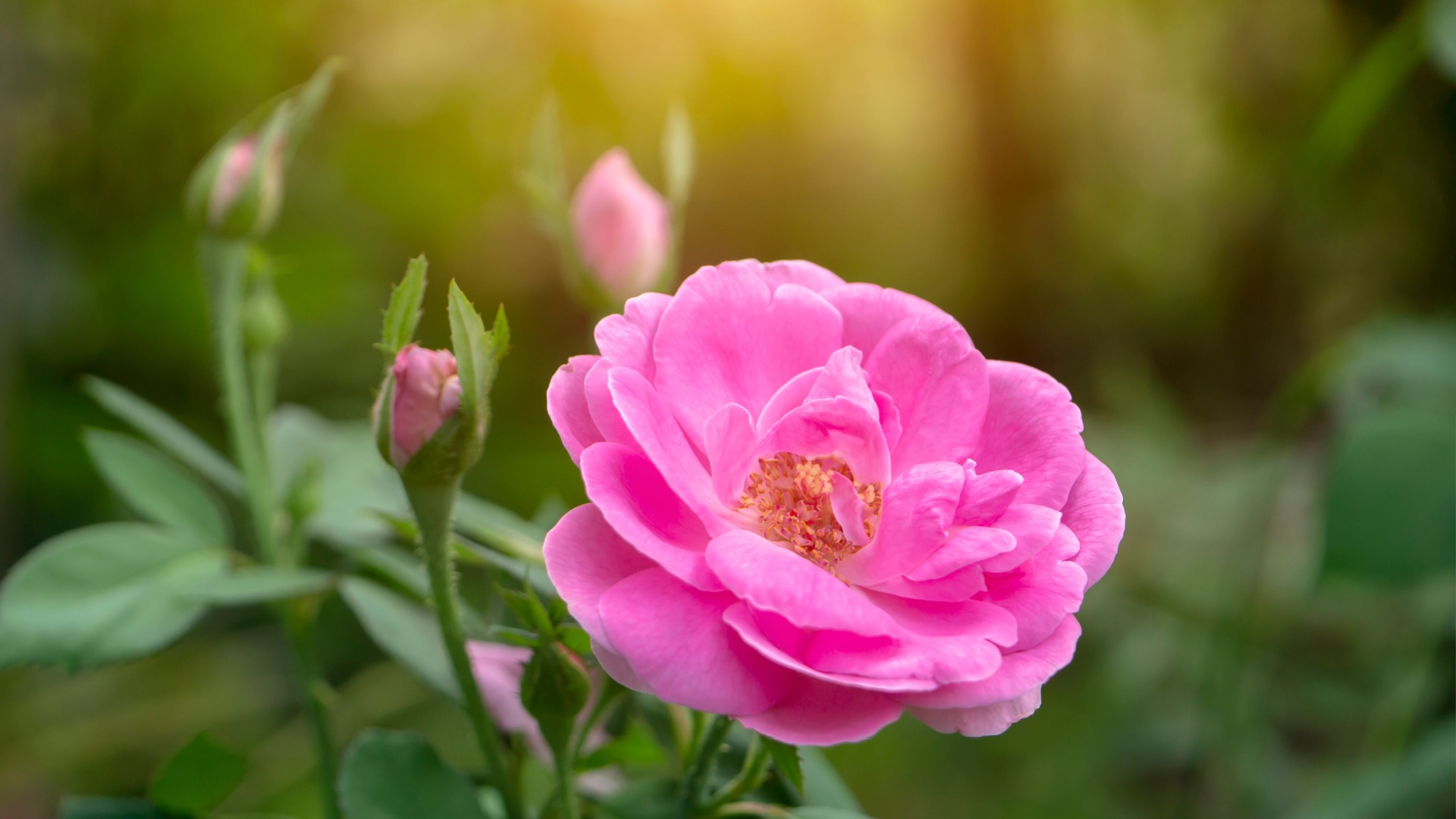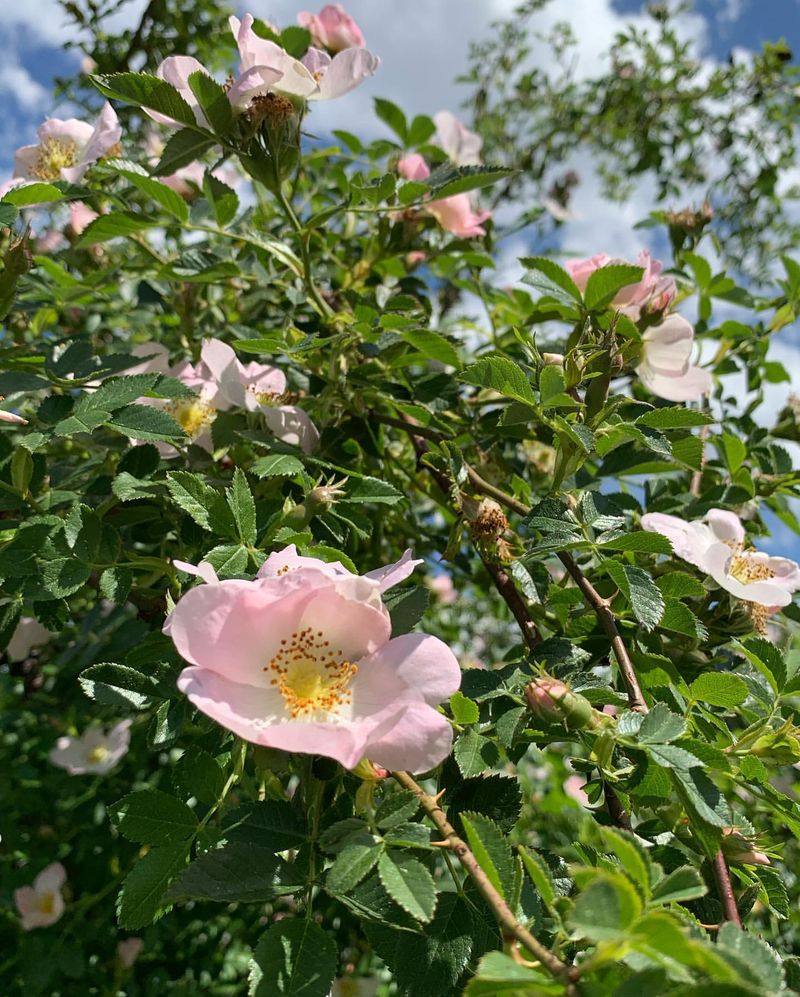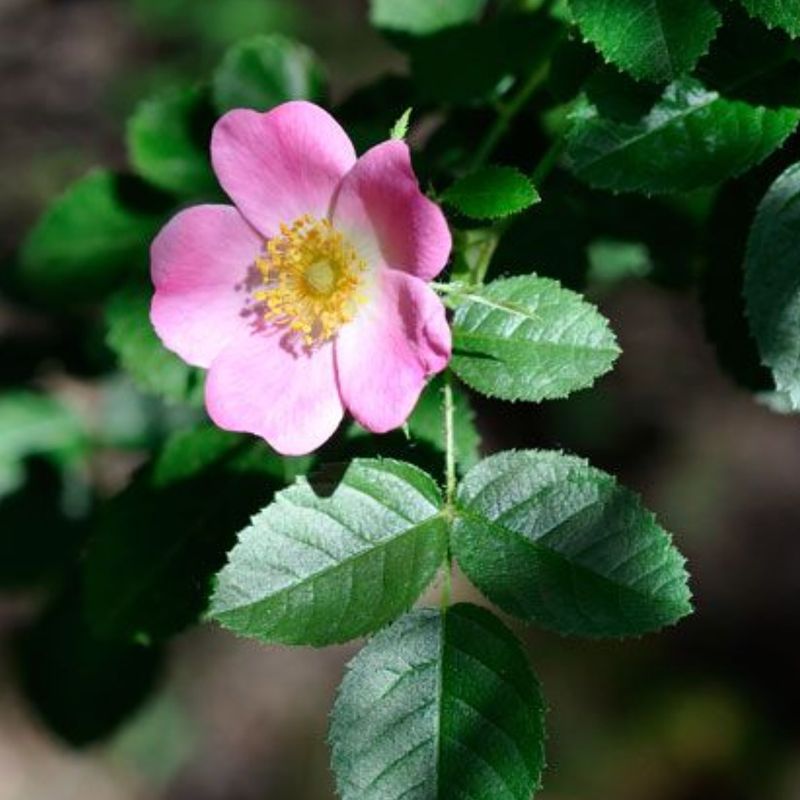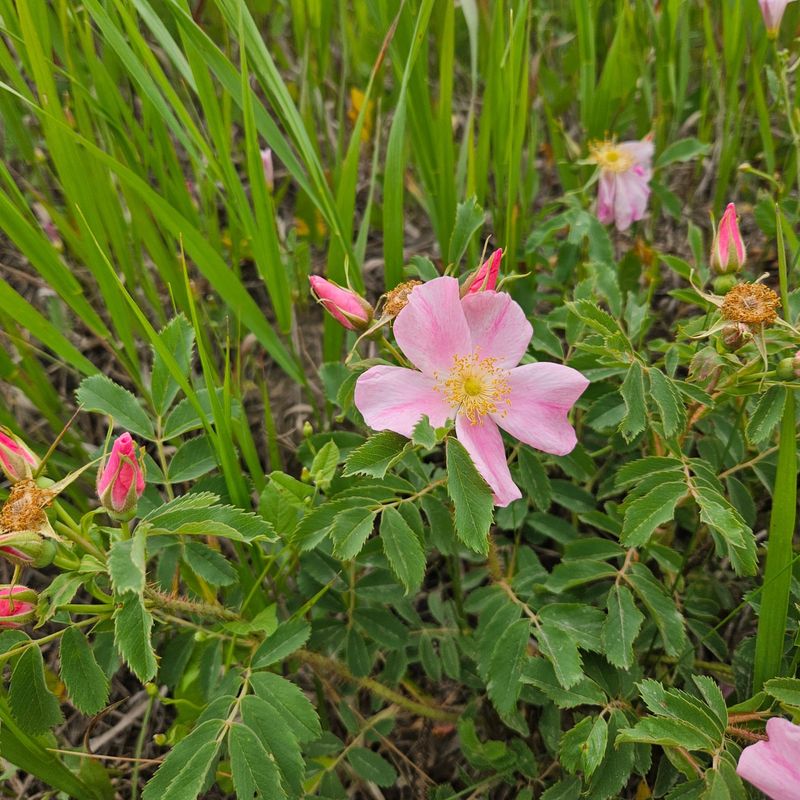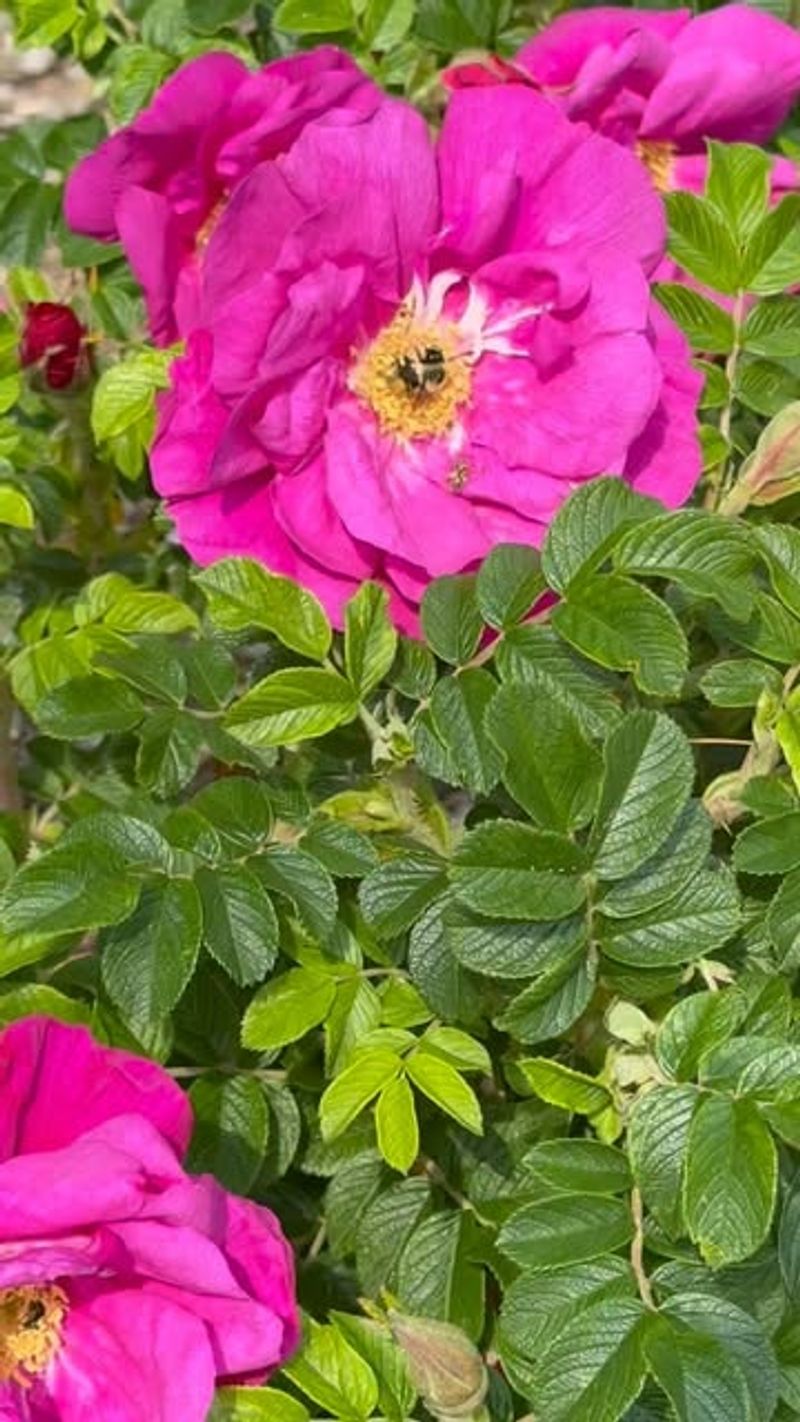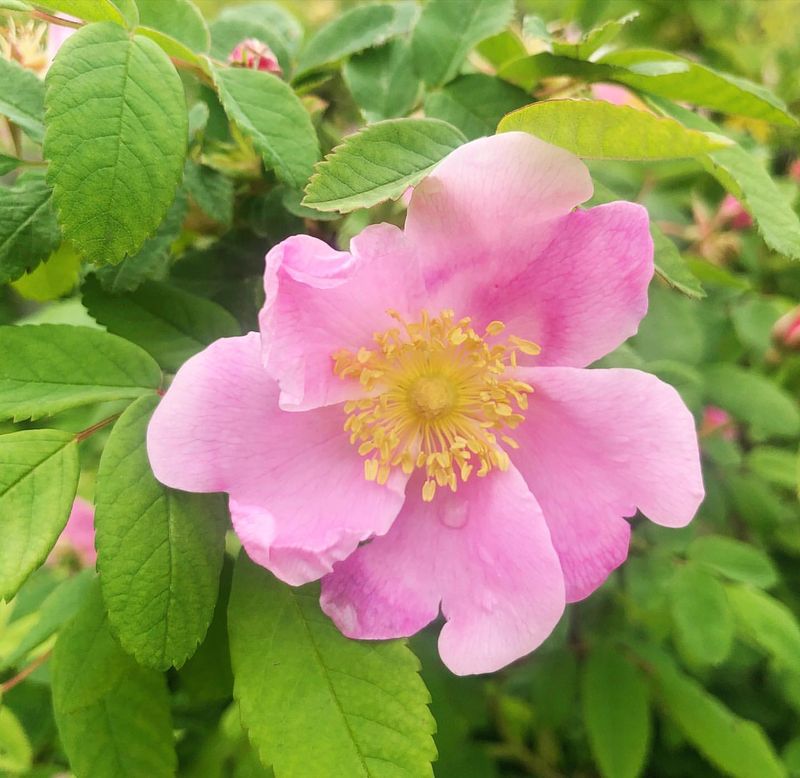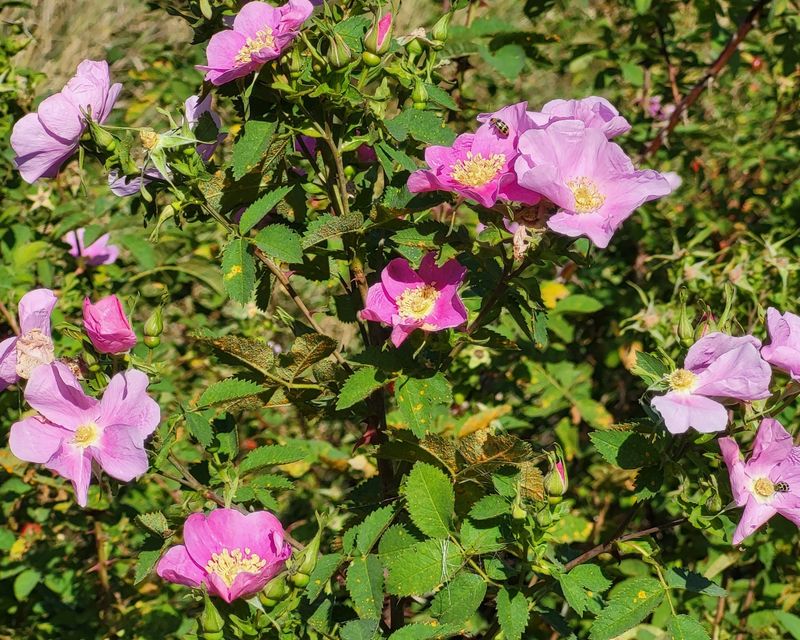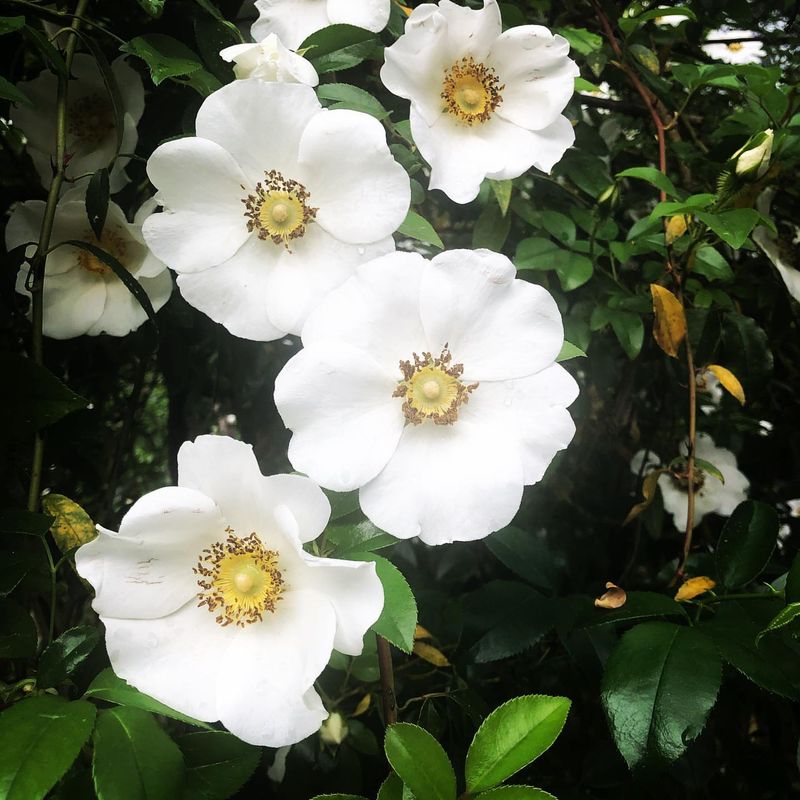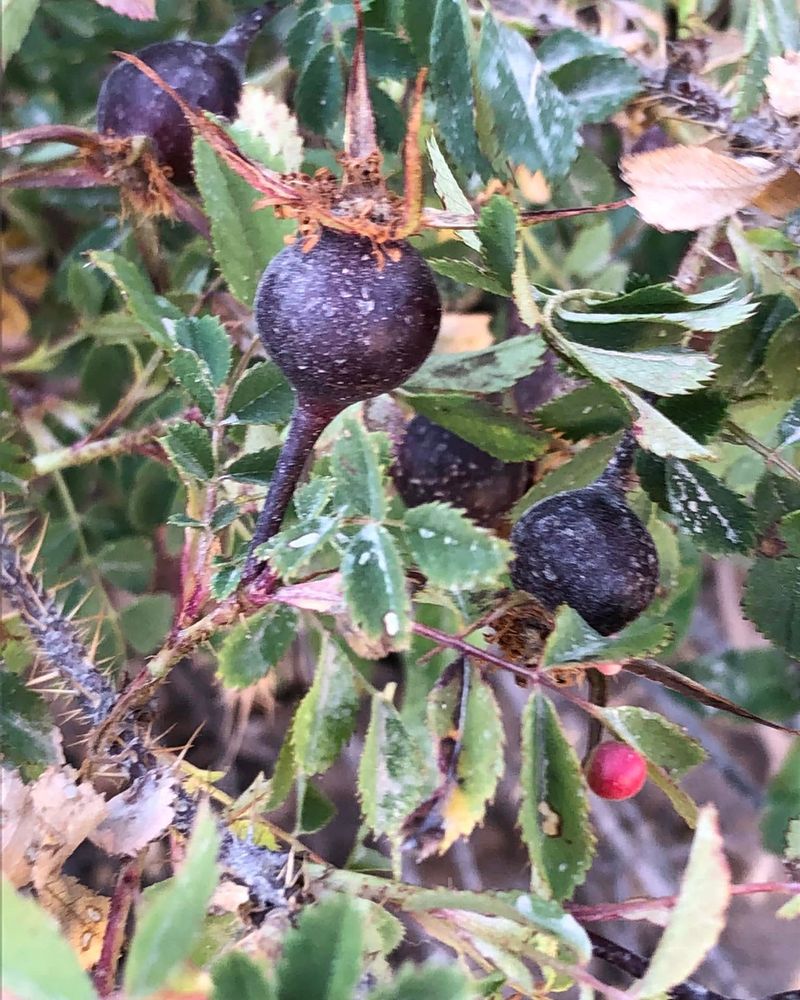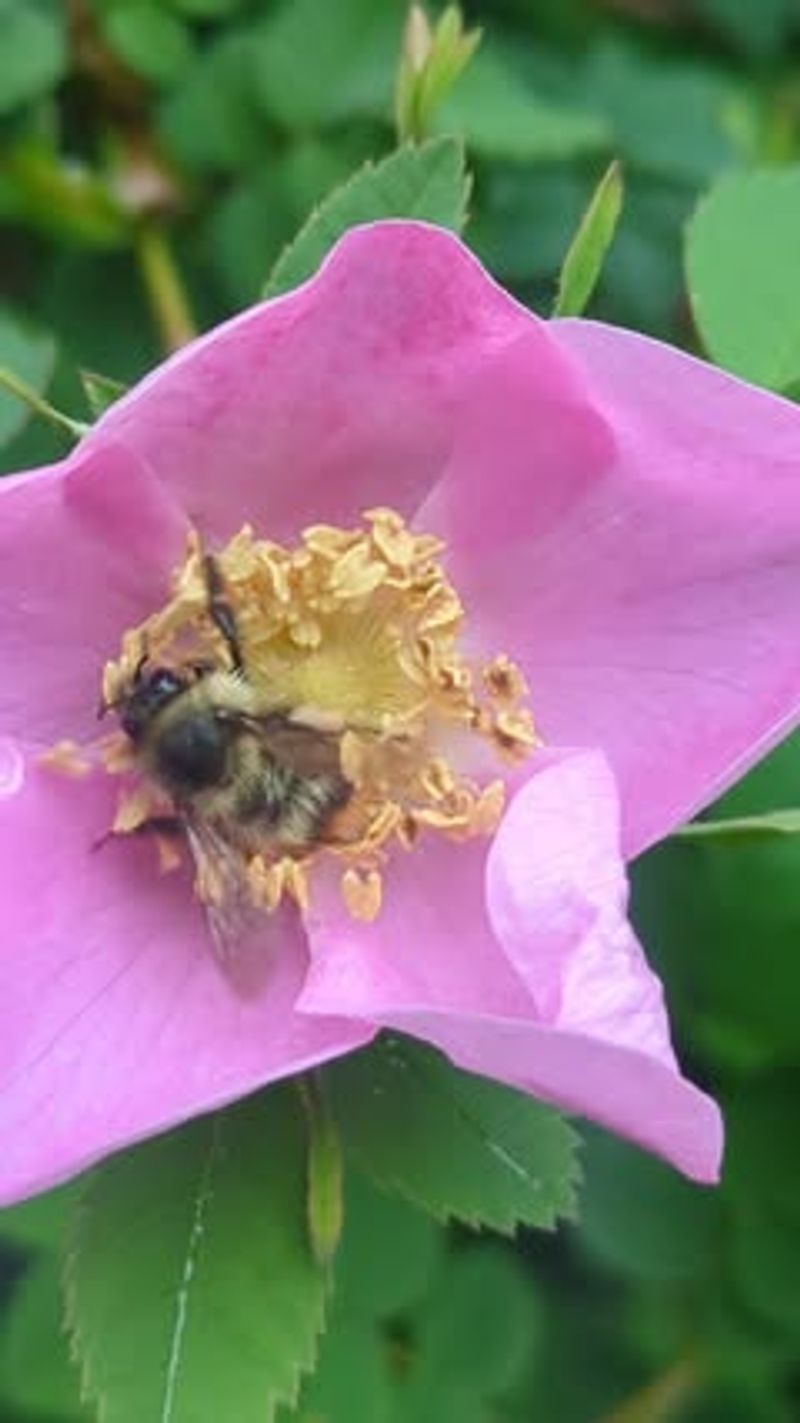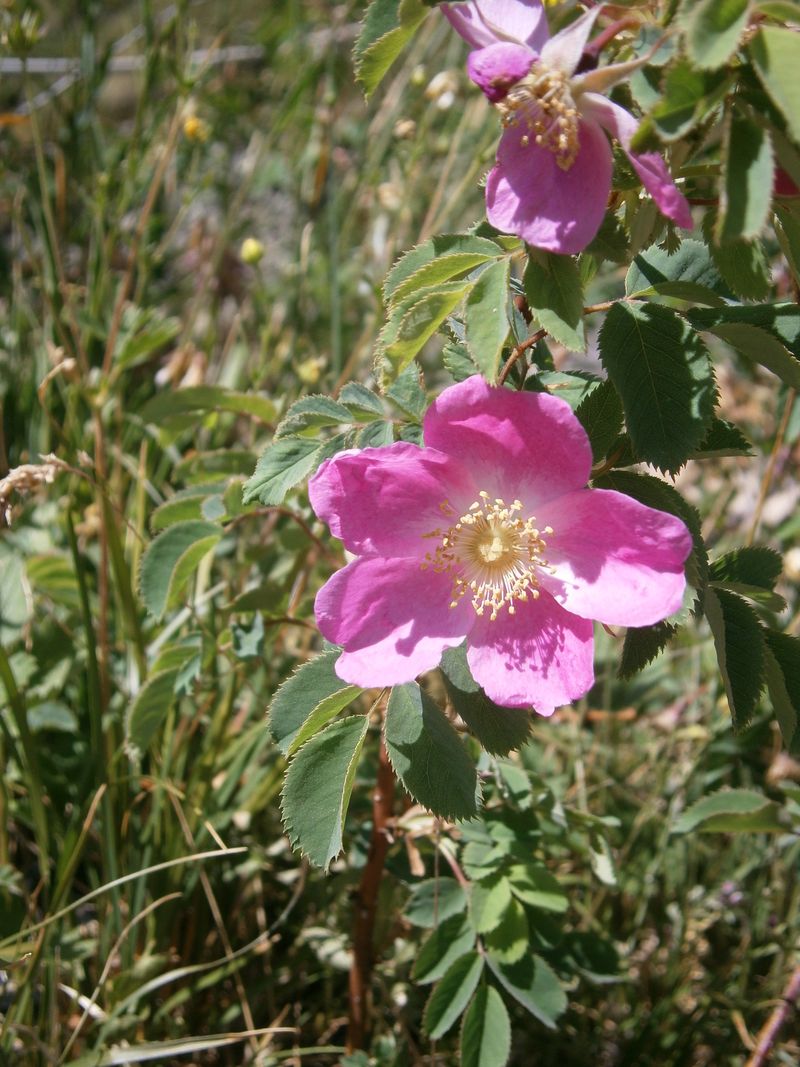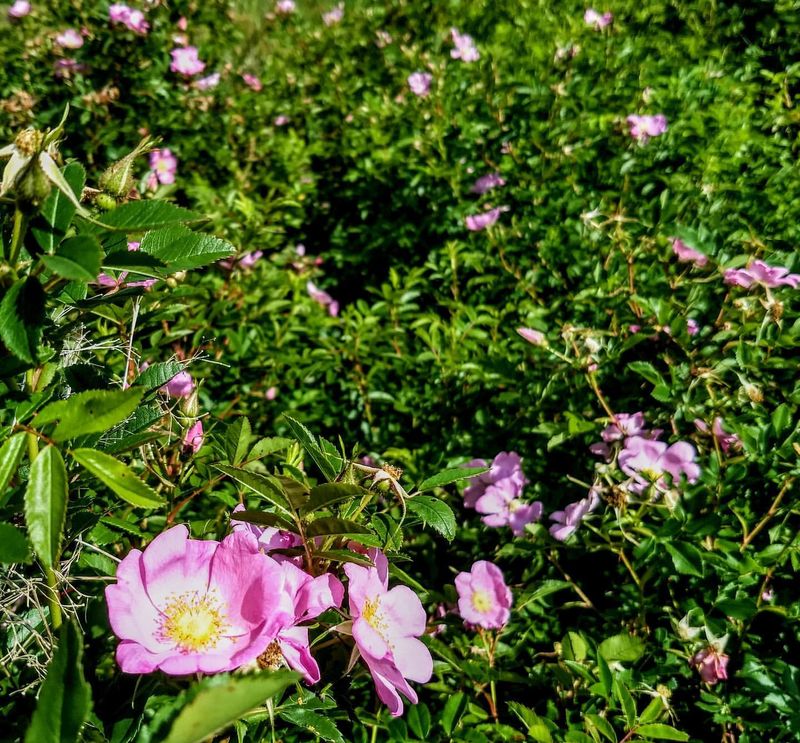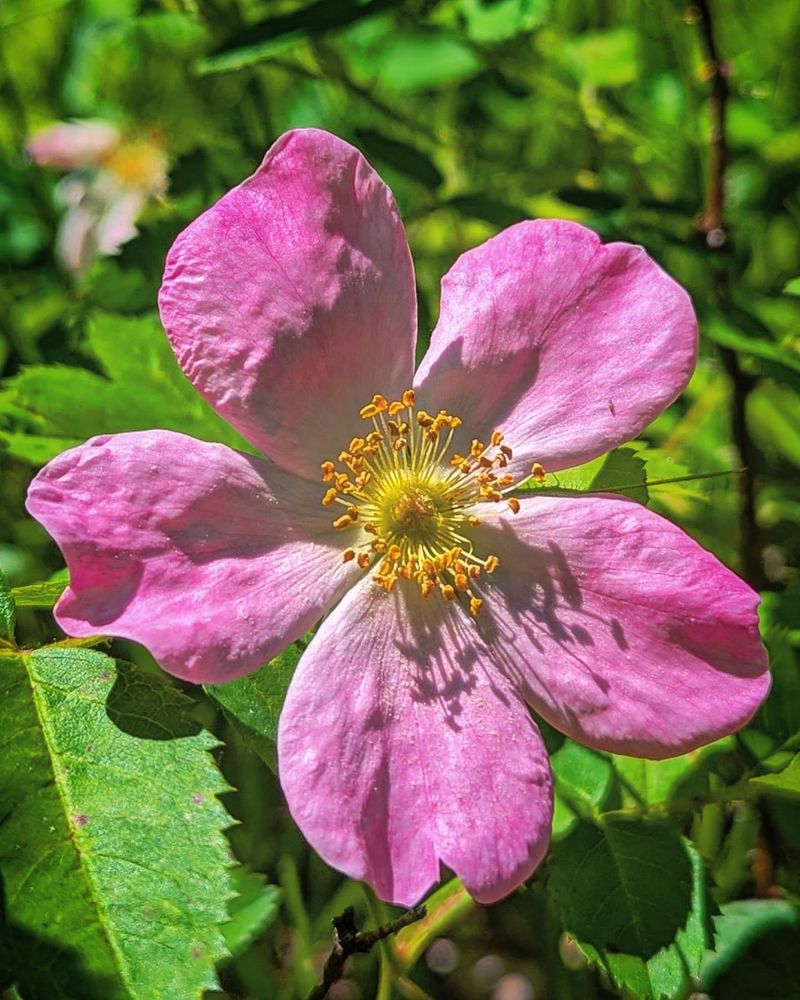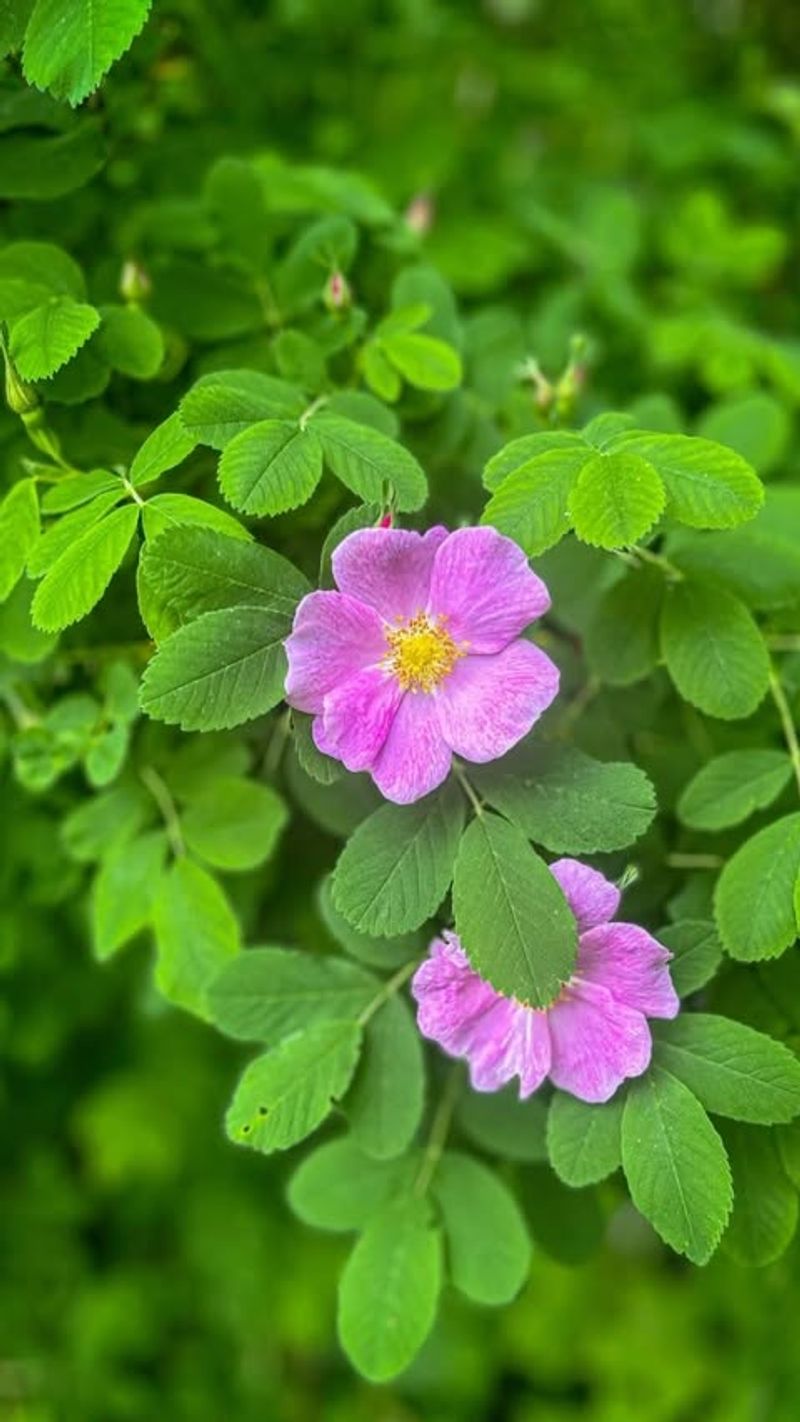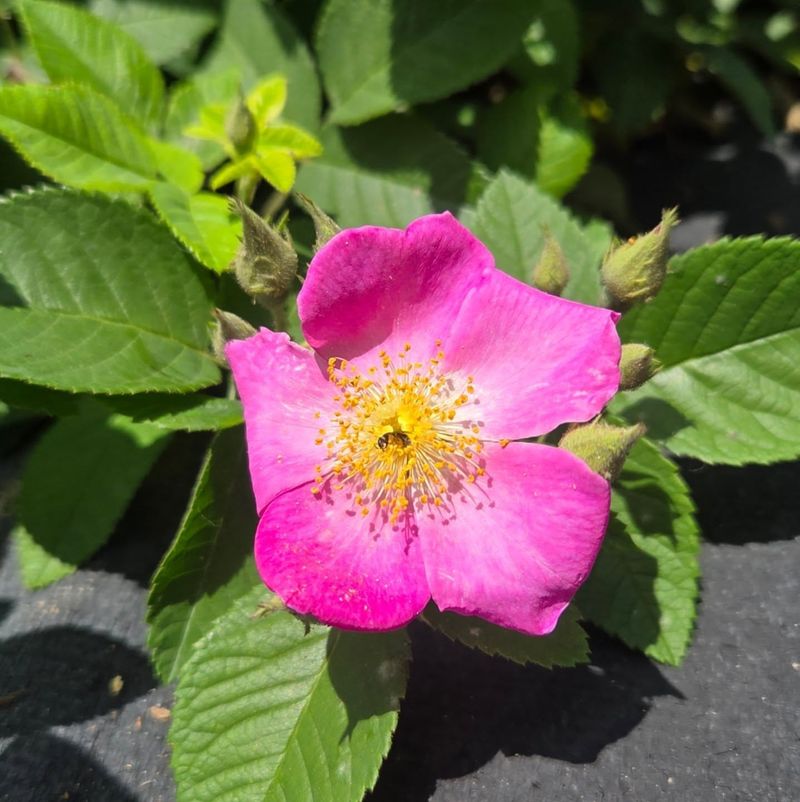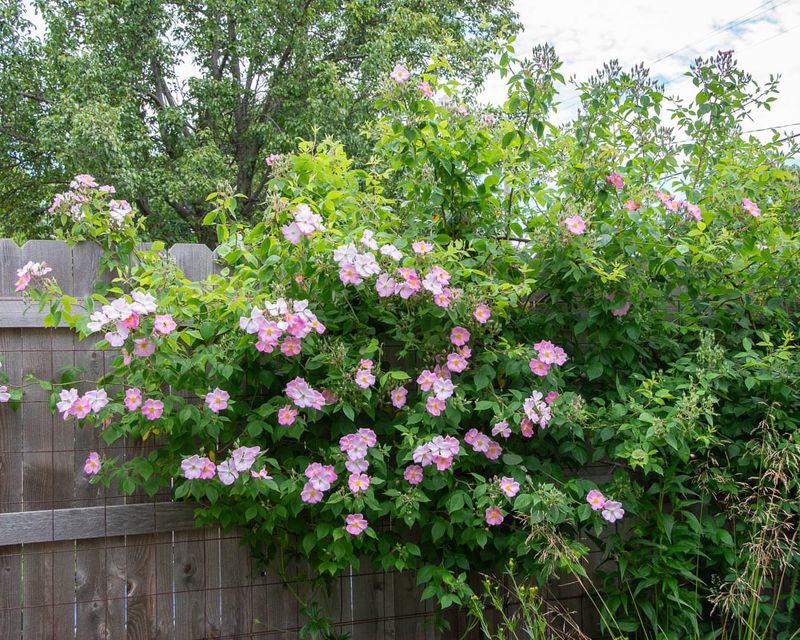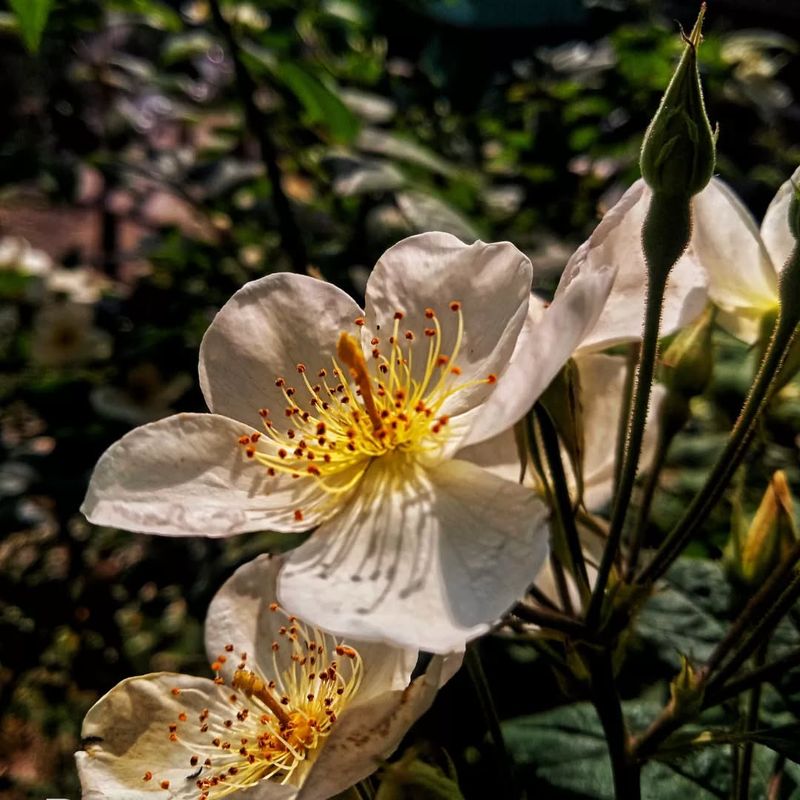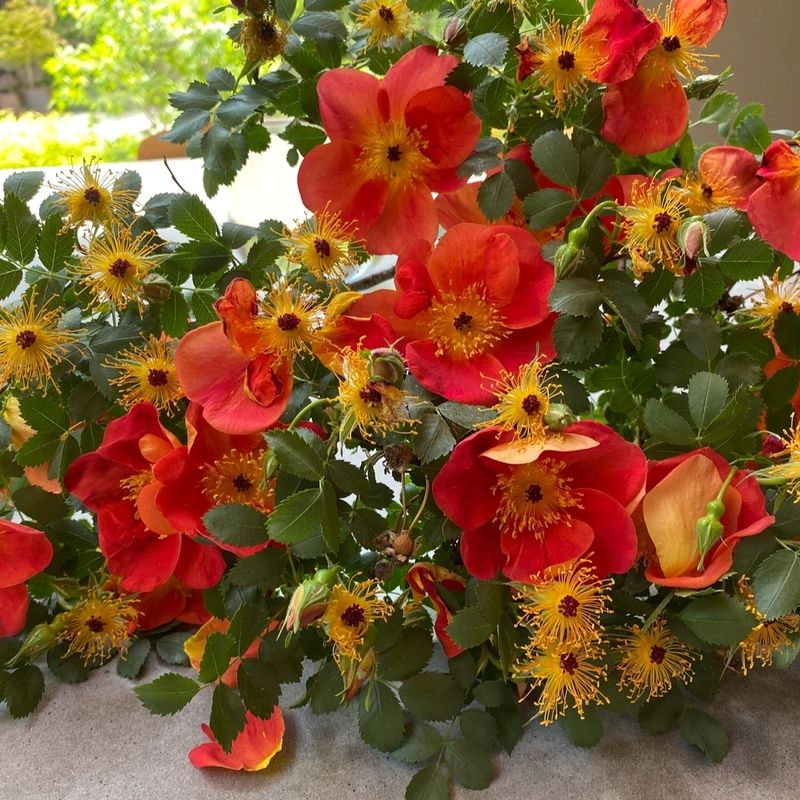Wild roses captivate gardeners with their natural charm and resilience. Unlike their perfectly manicured cousins, these untamed beauties offer simpler blooms, intoxicating fragrances, and remarkable hardiness.
Bringing these botanical treasures into your garden connects you with nature’s original designs while creating a haven for beneficial insects and birds.
1. Dog Rose (Rosa canina)
Arching stems covered in delicate pink blooms make the Dog Rose a countryside classic. Native to Europe, this wild beauty produces bright red rose hips packed with vitamin C – perfect for making tea or jam.
Growing up to 10 feet tall, it thrives in poor soil where fancier roses would fail. Birds adore the nutritious hips that persist through winter, creating a natural feeding station in your garden.
2. Sweetbriar Rose (Rosa rubiginosa)
Walk past a Sweetbriar after rain and you’ll be greeted by an apple-scented surprise! The leaves release this delightful fragrance when wet or crushed, earning its nickname ‘Eglantine Rose’.
Soft pink flowers appear in summer, followed by oval orange-red hips in fall. Hardy in zones 4-9, this European native reaches 6-8 feet tall and tolerates partial shade, making it versatile for difficult garden spots.
3. Prairie Wild Rose (Rosa arkansana)
Tough as the American plains it calls home, Prairie Wild Rose laughs at drought, cold, and poor soil. Standing just 18 inches tall, this compact beauty spreads slowly through underground runners to form natural colonies.
Fragrant pink flowers appear in June, giving way to round, bright red hips that persist through winter. Native Americans used every part of this plant – petals for tea, hips for food, and roots for medicine.
4. Rugosa Rose (Rosa rugosa)
Beachcombers know Rugosa Rose as the salt-spray-loving tough guy of the rose world. Originally from Asia, it now naturalizes along coastal areas with its wrinkled, leathery leaves that shrug off salt, wind, and disease.
Massive red-orange hips follow the fragrant pink or white blooms – each hip contains 60-80 seeds! Wildlife adores them, and humans can transform them into vitamin-rich jams. Rugosas need zero babying, making them perfect for novice gardeners.
5. Virginia Rose (Rosa virginiana)
Native American heritage blooms in the Virginia Rose, with its shiny reddish stems adding winter interest when leaves drop. Summer brings clusters of fragrant pink flowers that pollinators can’t resist. Fall transforms this eastern U.S. native into a showstopper with scarlet hips and burgundy-orange foliage.
Growing 4-6 feet tall, it forms thickets perfect for wildlife shelter and natural garden boundaries. Even black bears snack on its nutritious hips!
6. California Wild Rose (Rosa californica)
Golden State gardeners treasure this drought-tolerant native that thrives in both sun and partial shade. Pale pink, delicately scented blooms appear from spring through summer, attracting beneficial insects and butterflies.
Growing 3-6 feet tall, California Wild Rose forms protective thickets along streams and woodland edges. Indigenous peoples harvested the vitamin-rich hips for food and medicine. Modern gardeners appreciate its water-wise nature and wildlife-friendly habits.
7. Cherokee Rose (Rosa laevigata)
Legend tells that Cherokee Rose sprang from the tears of Native American mothers forced along the Trail of Tears. This evergreen climber bears pristine white flowers with golden centers against glossy dark green leaves.
Despite being Georgia’s state flower, it actually originated in China! Reaching 10-20 feet, it creates spectacular flowering hedges or trellised displays. The large pear-shaped hips turn from green to red as they ripen, adding months of visual interest.
8. Scotch Rose (Rosa spinosissima)
Medieval Scottish gardens featured this petite charmer, whose Latin name means “most thorny rose” – a fitting description for its densely armed stems. Standing just 2-3 feet tall, it’s perfect for smaller gardens and rock gardens.
Creamy white or pale pink blooms appear in late spring, followed by purple-black hips that contrast dramatically with the small, ferny foliage. Extremely cold-hardy (zones 3-8), it thrives in poor soil where pampered roses would sulk.
9. Nootka Rose (Rosa nutkana)
Pacific Northwest natives used Nootka Rose thorns as fishing hooks and sewing needles. Large, solitary pink blooms grace this 6-foot shrub in early summer, releasing a sweet perfume that fills the air. Excellent for erosion control on slopes, it spreads slowly through underground runners.
The sizeable red hips contain more vitamin C than oranges! Wildlife depends on its dense growth for shelter, while gardeners appreciate its disease resistance and low maintenance.
10. Wild Alpine Rose (Rosa pendulina)
Mountain hikers treasure glimpses of the Wild Alpine Rose clinging to rocky slopes across European highlands. Thornless stems make this 3-foot shrub surprisingly friendly to touch – a rarity in the rose world!
Vibrant magenta-pink blooms appear in early summer, followed by distinctive flask-shaped red hips that dangle like ornaments. Perfectly adapted to harsh conditions, it thrives in rocky, well-drained soil and tolerates partial shade better than most roses.
11. Swamp Rose (Rosa palustris)
Moisture-loving Swamp Rose defies the typical rose preference for dry feet. Native to eastern North America, it happily grows in boggy areas, rain gardens, and pond edges where other roses would quickly rot.
Clusters of fragrant pink flowers bloom later than most wild roses, extending the season into mid-summer. Growing 4-7 feet tall, it provides important habitat for birds and small mammals. The small, round red hips persist through winter, brightening dreary days.
12. Pasture Rose (Rosa carolina)
Early American settlers noticed Native Americans gathering Pasture Rose for food and medicine. This low-growing beauty (2-3 feet) spreads slowly to form colonies in sunny meadows and woodland edges. Single pink flowers with yellow centers appear in late spring, releasing a sweet fragrance that attracts beneficial insects.
Excellent for naturalistic gardens, it combines beautifully with native grasses and wildflowers. The bright red hips provide winter food for birds and small mammals.
13. Woods’ Rose (Rosa woodsii)
Rocky Mountain gardeners cherish Woods’ Rose for its incredible adaptability to harsh conditions. From desert canyons to mountain forests, this tough native thrives where temperatures swing dramatically between seasons.
Clusters of pink flowers bloom in early summer, releasing a light, sweet fragrance. Growing 4-6 feet tall, it forms thickets that provide essential wildlife habitat. Indigenous peoples across western North America used its vitamin-rich hips for winter nutrition.
14. Burnet Rose (Rosa pimpinellifolia)
Ancient Romans cultivated Burnet Rose for its medicinal properties and delightful scent. The smallest of wild roses, it forms a compact mound just 1-2 feet tall with distinctive fern-like foliage that resembles the herb burnet.
Creamy white flowers with yellow centers appear in late spring, followed by shiny black hips that look like polished jet beads. Perfect for rock gardens and edges, it tolerates coastal conditions, poor soil, and drought once established.
15. Cinnamon Rose (Rosa majalis)
Medieval monks cultivated Cinnamon Rose in monastery gardens for its medicinal bark with a distinctive spicy scent. This ancient European native grows 5-7 feet tall with arching reddish-brown stems. Deep pink, highly fragrant flowers appear in early summer – often the first wild rose to bloom.
Unlike many wild roses, it rarely produces hips, focusing its energy on spreading through underground runners. The bronzy new growth adds extra visual interest in spring.
16. Climbing Prairie Rose (Rosa setigera)
America’s only native climbing rose scrambles gracefully through trees and over fences, reaching heights of 10-15 feet. Once called the “Michigan Rose,” this Midwest native blooms later than most wild roses, extending the season into early July.
Clusters of deep pink flowers fade to pale pink as they age, creating a multi-toned effect. Unlike most wild roses, it’s nearly thornless! The small red hips persist through winter, providing food for birds when other sources are scarce.
17. Himalayan Wild Rose (Rosa brunonii)
Mountain trekkers in Nepal often catch the heavenly fragrance of Himalayan Wild Rose before spotting its cascading white blooms. This vigorous climber can reach 20 feet, creating spectacular flowering curtains when trained on pergolas or allowed to scramble through trees.
The intensely fragrant white flowers with yellow centers appear in large clusters in early summer. Native to the foothills of the Himalayas, it’s surprisingly adaptable to temperate gardens, thriving in zones 6-9 with good drainage.
18. Austrian Copper Rose (Rosa foetida ‘Bicolor’)
Renaissance gardens featured this stunning ancient rose with its uniquely colored petals – fiery copper-red on top and golden-yellow underneath. The dramatic coloration creates a flickering effect in breeze that resembles dancing flames.
Growing 5-6 feet tall, this Middle Eastern native thrives in hot, dry conditions where many roses struggle. Despite its species name “foetida” (meaning smelly), the flowers have a pleasant, spicy scent. One of the oldest cultivated roses, it’s been grown since at least 1590!
19. Macartney Rose (Rosa bracteata)
Glossy, evergreen leaves make Macartney Rose stand out among deciduous wild roses. Named after Lord Macartney who introduced it from China in 1793, this semi-climbing rose reaches 6-10 feet with gracefully arching stems.
Large, pristine white flowers with prominent golden stamens resemble fried eggs – earning it the nickname “Egg Rose.” Thriving in zones 7-9, it’s particularly heat and drought tolerant once established. The fuzzy brown hips add winter interest in milder climates.

